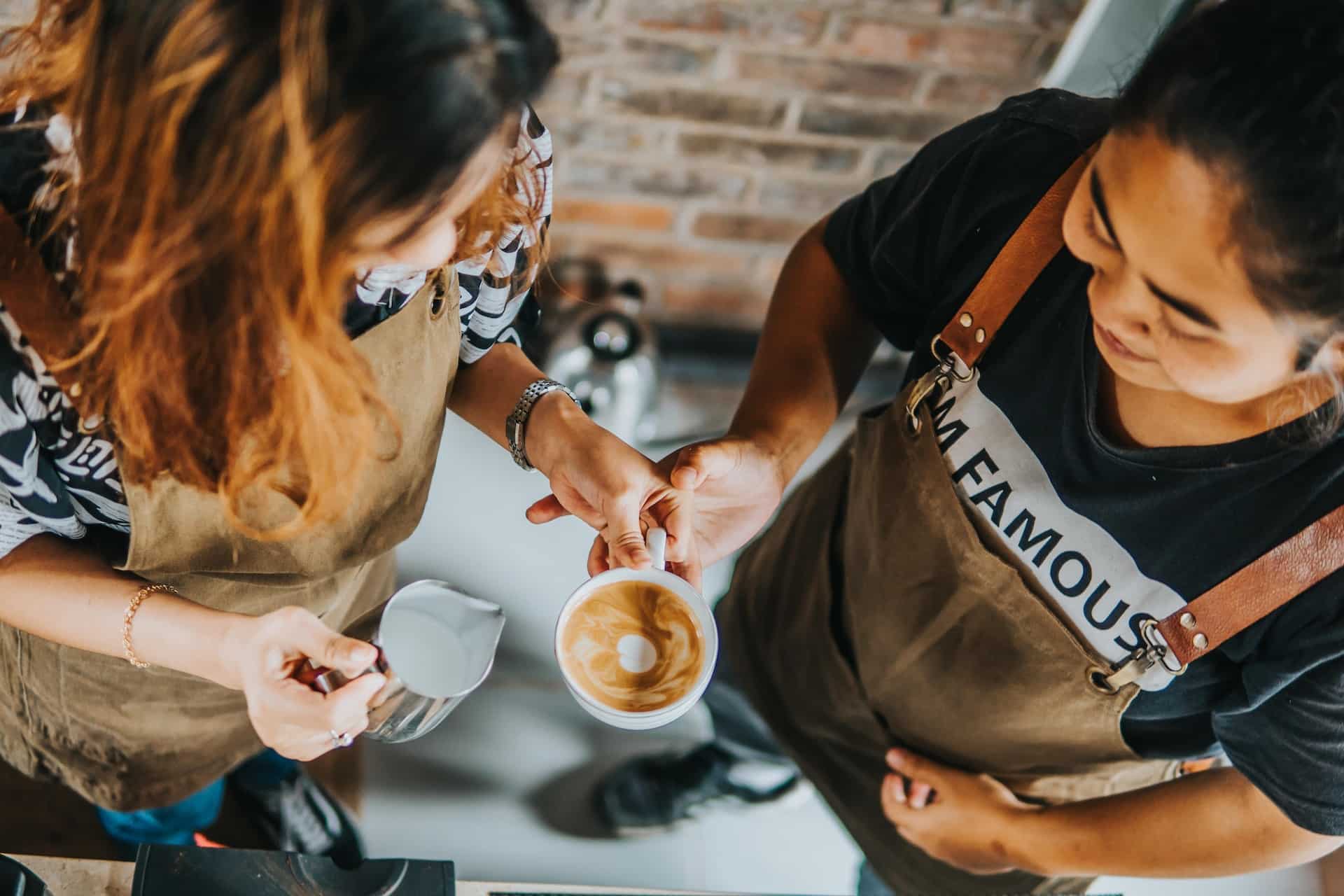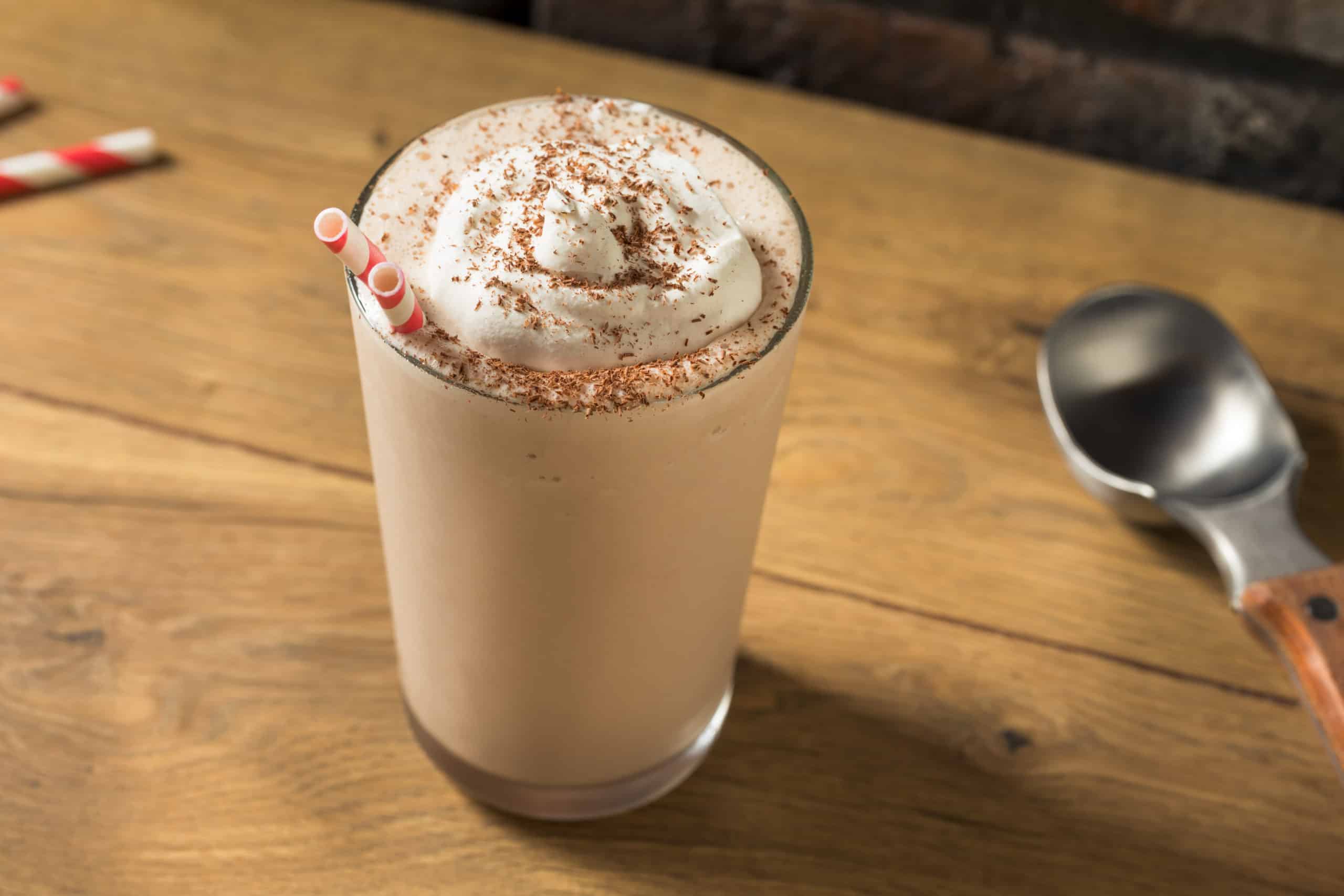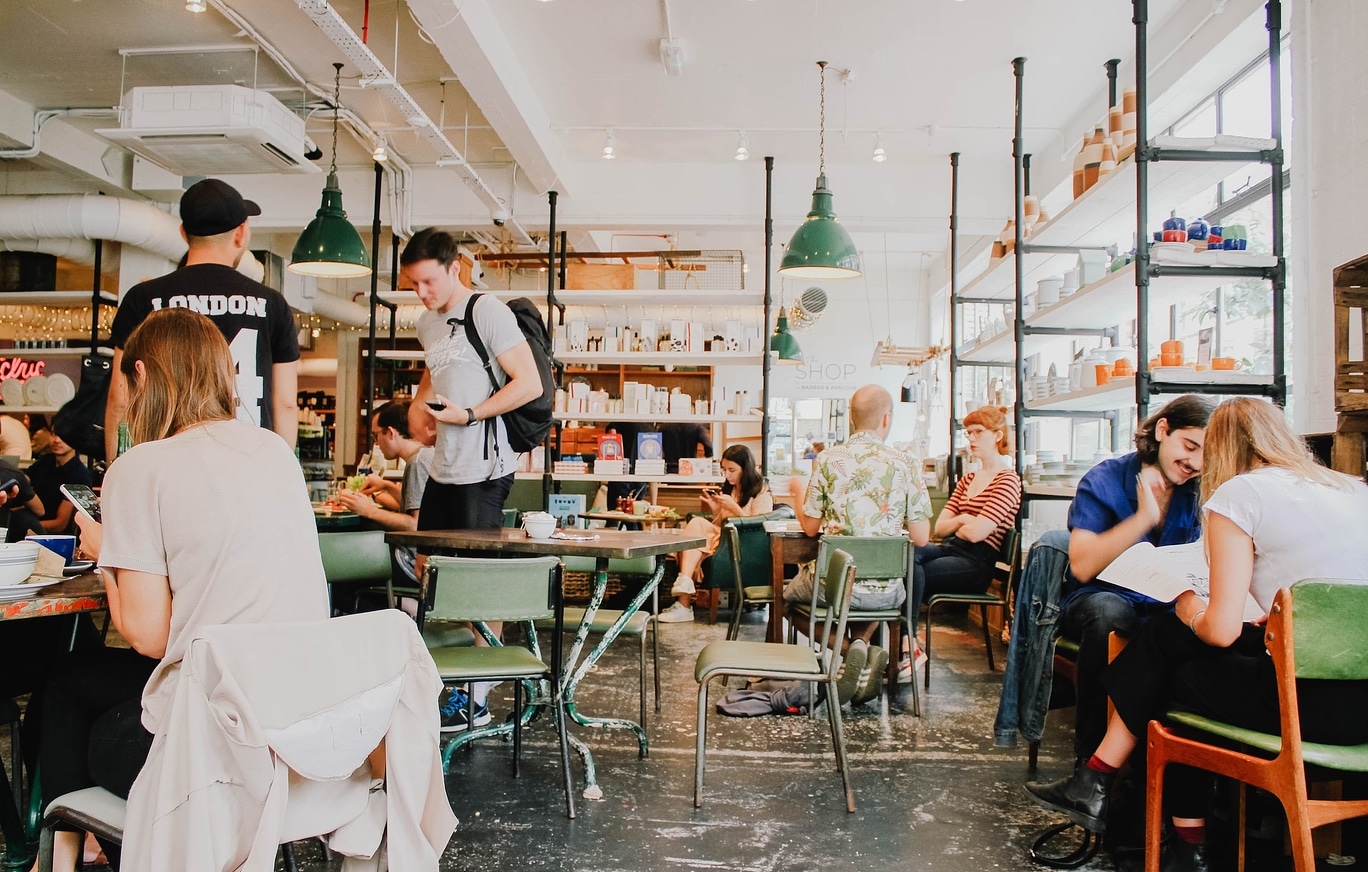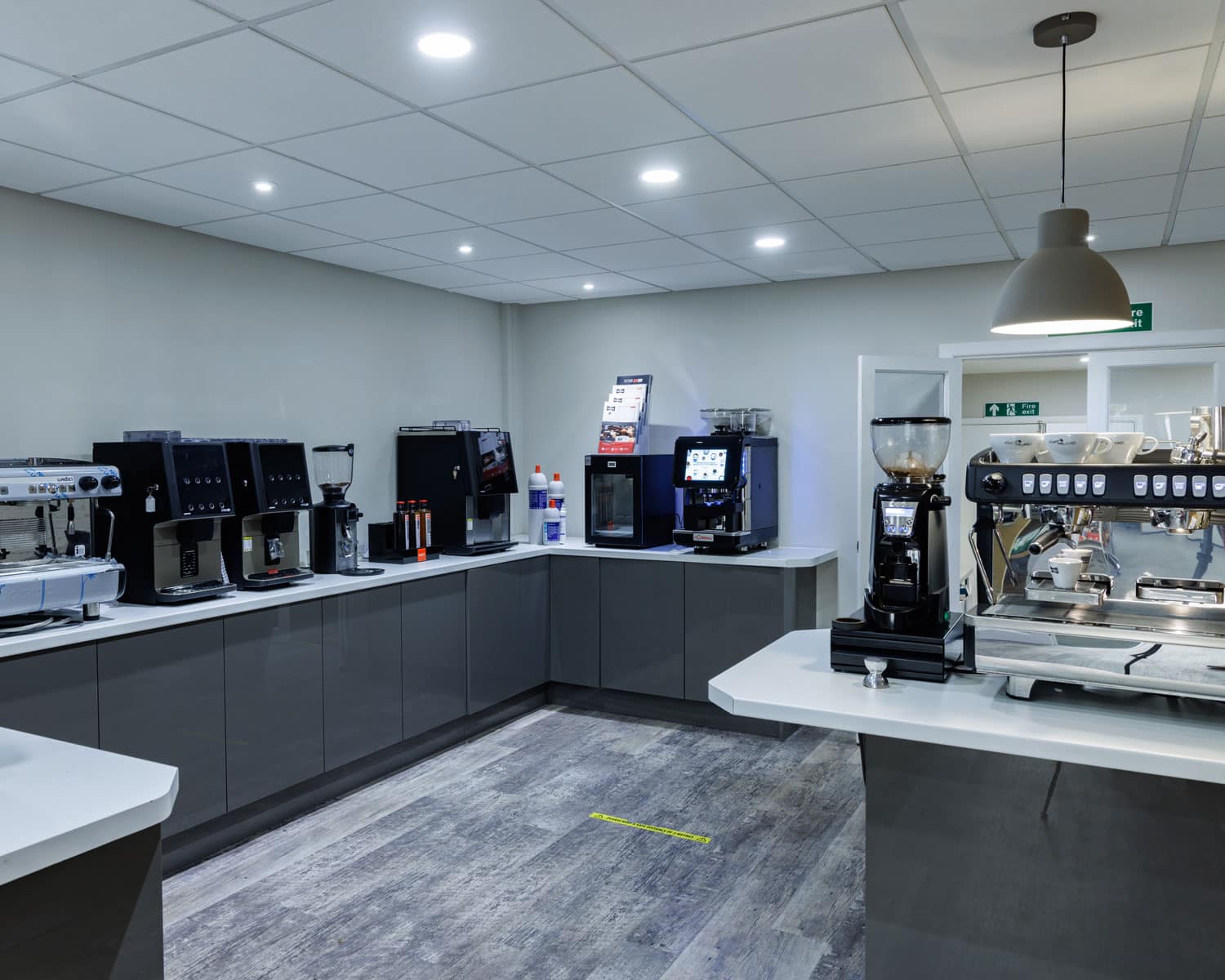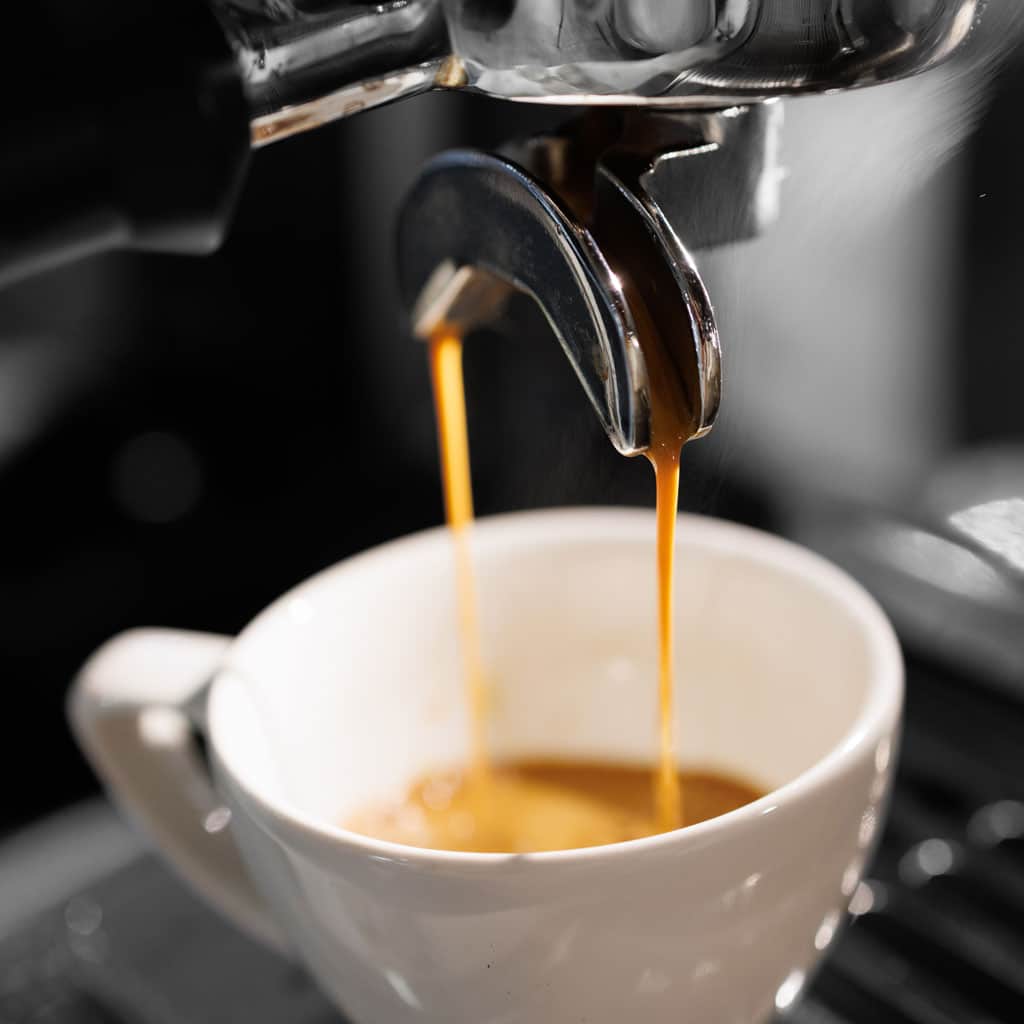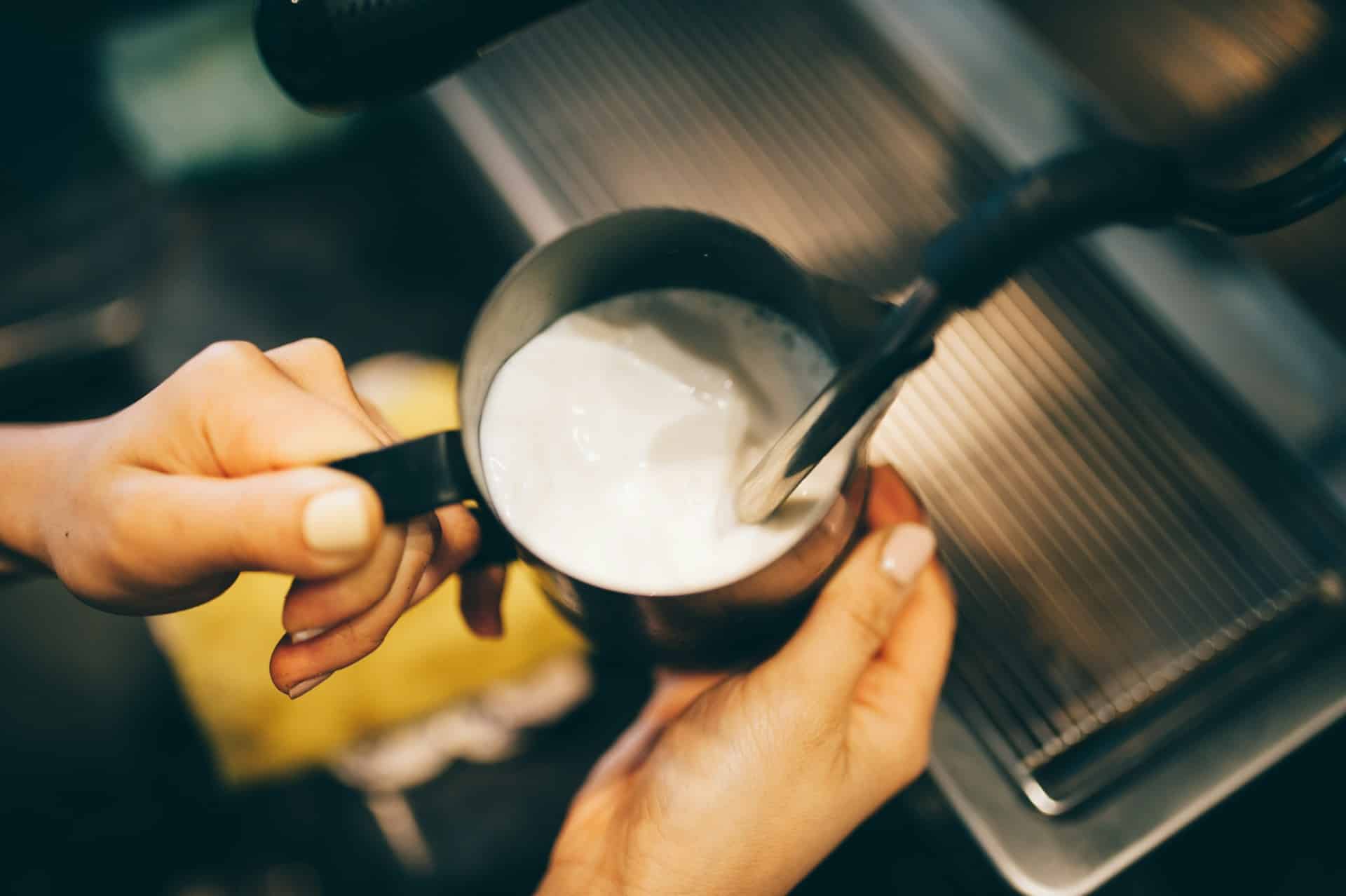Table of Contents
The Importance Of Barista Training
A well-trained barista possesses a diverse set of skills that go beyond simply making espresso-based drinks. They understand the nuances of coffee beans, the various brewing methods, and how to create a range of different drinks, all of which contribute to elevating the coffee-drinking experience.
It is the barista’s job to encourage customers to feel welcome and appreciated by engaging with them. They should be able to recommend beverages that suit individual tastes, answer questions about coffee origins, and create a warm, inviting atmosphere that encourages customers to return.
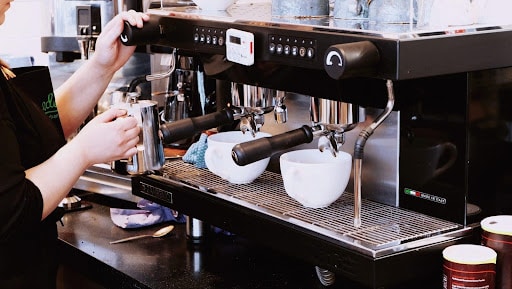
All Things Coffee
It is vital for your baristas to understand ‘all things coffee’. Using this guide, you will be able to ensure this is the case.
An introduction to coffee
Consistency is key in the coffee industry, and proper training ensures that each cup of coffee is prepared with precision and care. The first step towards this is understanding the different types of coffee.
Types of coffee
From lattes to cappuccinos, there are several different kinds of coffee-based drinks that must be mastered by your baristas.
Espresso
Espresso is a method of preparation that takes finely ground coffee, compacts it into a portafilter and forces hot water through it under high pressure to make a concentrated coffee beverage.
An espresso is a concentrated and bold coffee with a distinctive flavour profile, characterised by its intense aroma, full-bodied nature, and rich crema (a layer of foam) on top. The term “espresso” originates from the Italian word meaning “pressed out” or “expressed.”
To make an espresso, the following 8 steps are typically followed:
- Remove the portafilter (Group handle) from the group head.
- Purge/Rinse out the group head to clean out any old coffee and pre-heat the group head.
- Knock out any old coffee and wipe the basket clean using a designated towel or brush.
- Dose the portafilter – Start by grinding a fresh batch of coffee beans to a fine consistency, suitable for your espresso brewing recipe.
- Distribute the coffee evenly and tamp it down firmly.
- ‘Bless’ the portafilter to wipe away any excess ground coffee.
- Insert the portafilter into the group head.
- Place cup and press the desired button to initiate the brewing process immediately.
According to the Specialty Coffee Association (SCA), 25–35 ml beverage prepared from 7–9 grams of coffee through which clean water of 90.5-96.1ºC has been forced at 9–10 atmospheres of pressure, and where the grind of the coffee is such that the brew time is 20–30 seconds.”
We did a survey on ‘how to make the perfect espresso’ and shared it with the owners of our favourite local coffee shops. Over 50% of coffee shop owners say that to create the perfect espresso the water should be 90 degrees celsius. 83% of owners recommend a brewing time of 25 seconds.
When it comes to the type of coffee beans to use, over 60% would recommend medium roast. Things are slightly more divided when we asked coffee owners if they weighed their coffee. This is a 50/50 split between those who do and those who don’t.
Latte
A latte is made with a single or double shot of espresso (1/3 of your drink) and 2/3 of your drink is steamed milk with a small layer (around 1 cm) of frothed milk. The texture of a latte is very important and gives that little bit of extra to the beautiful appearance of this drink.
The name “latte” comes from the Italian caffè latte, which means “milk coffee.”
To make a latte, the following steps are typically followed:
- Start by brewing a double shot of espresso using an espresso machine.
- Meanwhile, texture and steam the desired amount of milk using a steam wand on the espresso machine.
- Pour textured steamed milk
- over the espresso shots in a serving cup.Optional: Create latte art by using the milk foam to draw patterns on the surface of the Latte. Add any desired flavourings or syrups, such as vanilla or caramel.
Americano
An Americano is espresso lengthened with hot water. Pour the water first to maintain the attractive crema on top. Milk can be served on the side if requested.
The name “americano” is said to have originated during World War II when American soldiers stationed in Europe diluted their espresso to match the milder taste of American coffee.
To make an Americano, the following steps are typically followed:
- In a serving cup, pour hot water into the cup until it is about two-thirds full.
- Add the double shot of espresso to the cup, gently pouring it over the hot water.
3. Optional: Add milk/
Cappuccino
An Espresso topped with a combination of steamed milk and foamed milk. Typically, 1/3 coffee, 1/3 steamed milk, 1/3 foamed milk. A cappuccino is a balanced combination of espresso, steamed milk, and frothed milk, with a distinctive layered appearance. The name “cappuccino” is derived from the resemblance of its colour to the brown robes worn by Capuchin friars, a religious order of the Catholic Church.
To make a cappuccino, the following steps are typically followed:
- Start by brewing a double shot of espresso using an espresso machine.
- While the espresso is brewing, steam and froth the desired amount of milk using a steam wand on the espresso machine. The milk should have a velvety texture and creamy consistency.
- Pour the espresso into a serving cup.
- Pour steamed, foarmed milk over the espresso shots in a serving cup. Traditionally cappuccino should have a drown 1/2cm ring and a white top.
- Optional: Dust the top of the frothed milk with cocoa powder.
Mocha
A mocha is a delightful combination of rich espresso, creamy steamed milk, and chocolate. The term “mocha” originates from the port city of Mocha in Yemen, known for its historic trade in coffee beans.
To make a mocha, the following steps are typically followed:
- Start by brewing a double shot of espresso using an espresso machine.
- In a separate container, melt a desired amount of chocolate. This can be done by using chocolate syrup or melting chocolate pieces in hot water or milk.
- In a serving cup, combine the double shot of espresso with the melted chocolate, stirring until well mixed.
- Steam and froth the desired amount of milk using a steam wand on the espresso machine, similar to the process of making a latte.
- Pour the steamed milk into the cup, incorporating it into the espresso-chocolate mixture.
- Optional: Top the mocha with whipped cream and drizzle with additional chocolate syrup for added indulgence.
Flat White
A flat white is a blend of micro-foamed milk poured over a double shot of espresso, traditionally comes in an 8oz cup. A flat white is a popular espresso-based drink that originated in Australia or New Zealand and is now enjoyed worldwide.
To make a flat white, the following steps are typically followed:
- Start by brewing a double shot of espresso using an espresso machine.
- Steam milk using a steam wand on the espresso machine, aiming for a velvety and creamy texture without large bubbles. 1/2 cm foam level.
- Pour textured steamed milk over the espresso shots in a serving cup, .
- Optional: Create latte art by using the milk foam to draw patterns on the surface of the flat white.
Macchiato
A macchiato is a bold and concentrated espresso shot with a touch of milk or foam to add subtle richness and smoothness to the flavour. The term “macchiato” comes from the Italian word meaning “stained” or “spotted.”
To make a macchiato, the following steps are typically followed:
- Start by brewing a single shot of espresso using an espresso machine.
- Steam a small amount of milk using a steam wand on the espresso machine, creating a velvety microfoam.
- Pour the single shot of espresso into a demitasse cup or small serving cup.
- Add a 2 or 3 dollop of the milk foam to the top of the espresso.
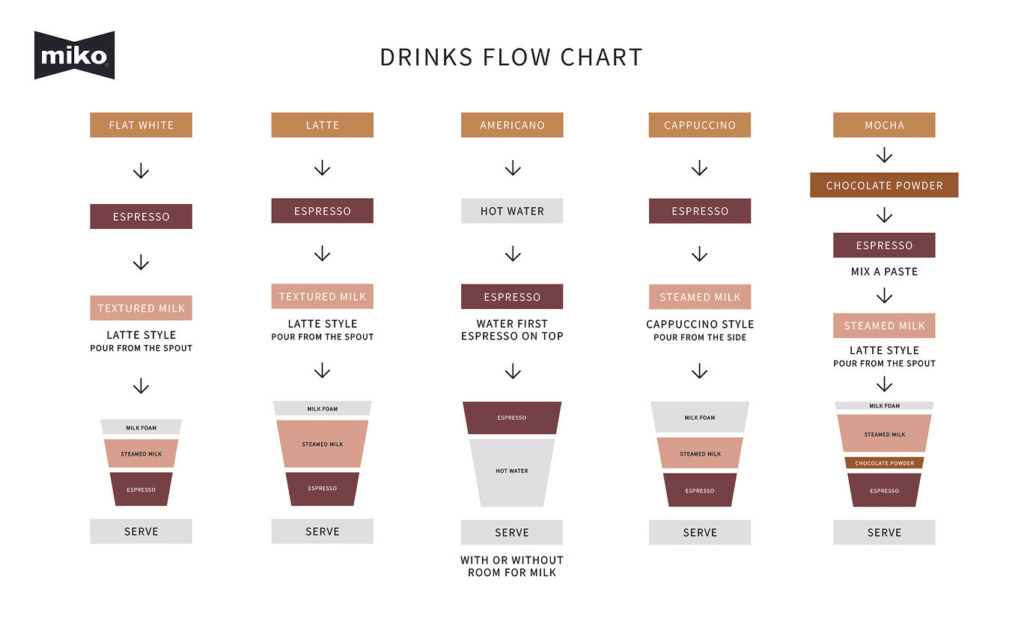
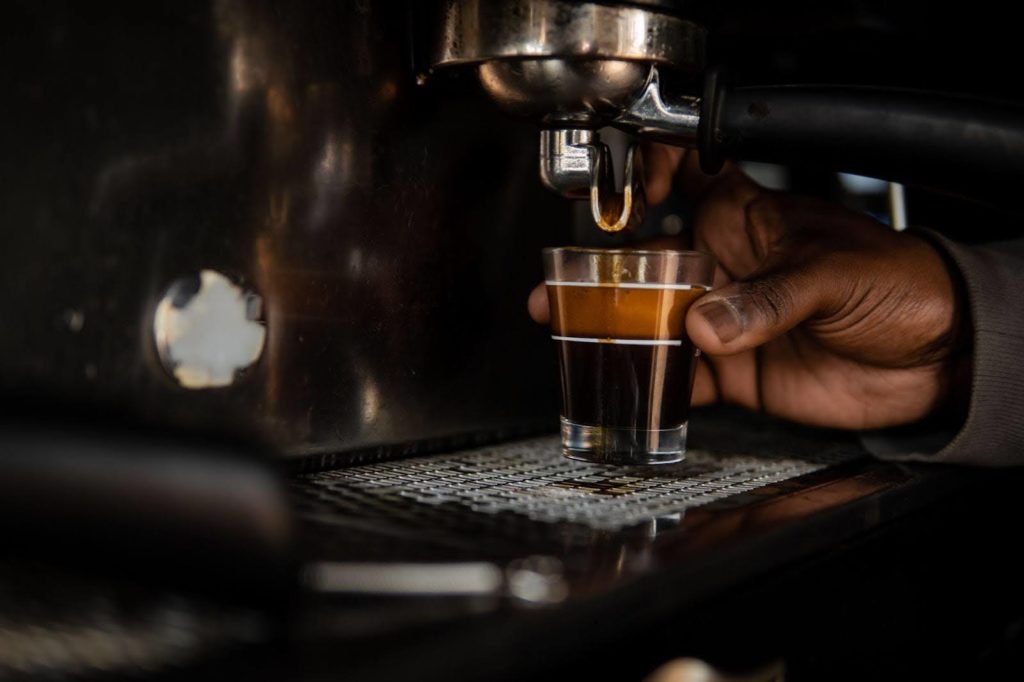
Coffee Beans and Blends
Different coffee beans provide different flavour profiles. It is important for your baristas to understand how different blends and roasts will influence the taste of the coffee they are serving.
Flavours
Coffee beans are typically roasted to various degrees to bring out their flavours and aromas. Common roast levels include light, medium, and dark roast.
Fruity
Coffee can have fruity flavours reminiscent of berries, citrus fruits, tropical fruits, or stone fruits like cherry or apricot.
Nutty
Some coffees have nutty flavours such as almond, hazelnut, or walnut. These flavours can be subtle or more pronounced, depending on the coffee.
Chocolate
Many coffees exhibit chocolate flavours, ranging from dark chocolate to milk chocolate, or even hints of cocoa or cacao.
Floral
Certain coffees have floral notes, similar to the aromas of flowers like jasmine, lavender, or rose.
Caramel or Sweet
Coffee can have caramel-like flavours, with a sweetness akin to brown sugar, caramelised sugar, or even honey.
Spiced
Some coffees have spiced undertones, including notes of cinnamon, cloves, nutmeg, or even black pepper.
Earthy
Earthy flavours can be found in some coffees, resembling tastes like tobacco, leather, or moss.
Wine-like
Certain coffees exhibit characteristics reminiscent of wine, with fruity, acidic, or even fermented flavours.
Herbal
Some coffees have herbal or tea-like qualities, with notes similar to chamomile, mint, or green tea.
Roasty or Toasty
Roasted coffee often develops flavours of caramelised sugars, toasted bread, or even smoky or burnt undertones.
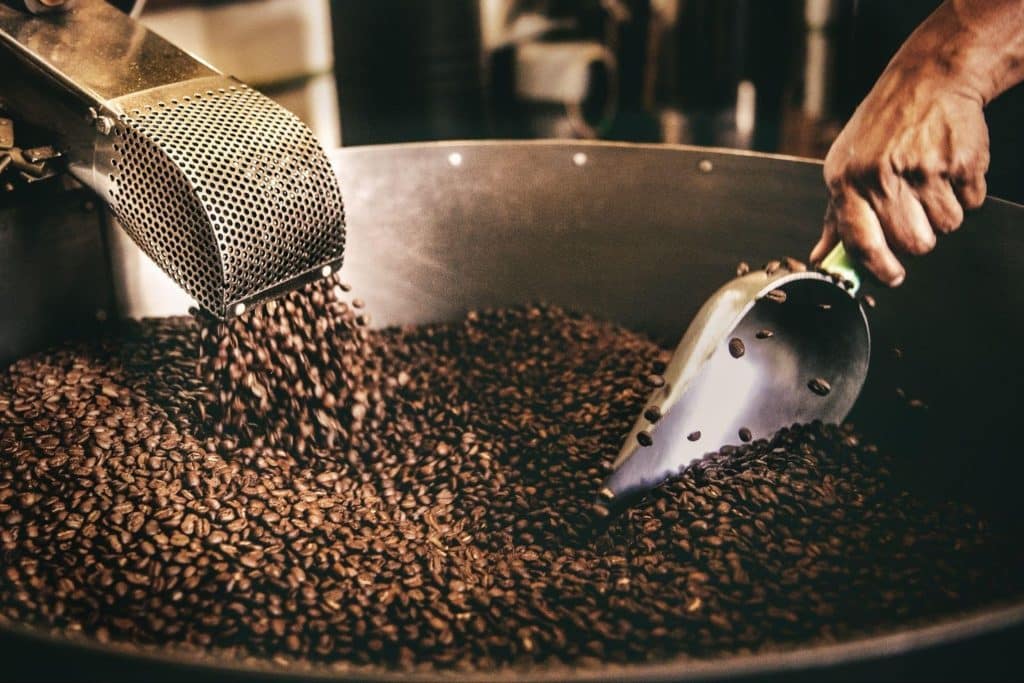
Characteristics
Coffee beans are the seeds of the coffee plant, which are harvested, processed, and roasted to create the coffee we enjoy.
There are two primary species of coffee beans: Arabica and Robusta.
Arabica beans are generally considered to have a more desirable flavour profile, with a smoother, sweeter taste and lower caffeine content. They are often associated with speciality coffees.
Robusta beans have a stronger and more bitter taste, with higher caffeine content. They are commonly used in blends or for espresso preparations where a stronger flavour and crema are desired.
Coffee Blends
Coffee blends are created by combining different types of coffee beans to achieve a desired flavour profile or characteristics.
Blends often involve a mixture of Arabica and Robusta beans, although some blends may consist solely of Arabica beans. Blending allows coffee roasters to balance flavours, acidity, body, and aroma to create a unique and consistent taste.
Sustainable
If your cafe has a focus on sustainability and already has some green credentials, make sure that you are stocking sustainable coffee (and that your baristas have done their research, in case they are asked).
Sustainable coffee refers to the cultivation, production, and trade of coffee beans in a manner that preserves the environment, protects biodiversity, and ensures fair and ethical treatment of coffee farmers and workers. It involves a holistic approach to coffee farming that considers the well-being of the ecosystem, the people involved, and the long-term viability of the coffee industry.
Puro Coffee is a coffee brand passionate about making a difference. Sourced from small-scale farmers in Peru, Honduras, and Ethiopia, who use the most organic and sustainable farming practices. At Miko Coffee, we stock and supply cafes around the country with delicious Puro coffee beans.
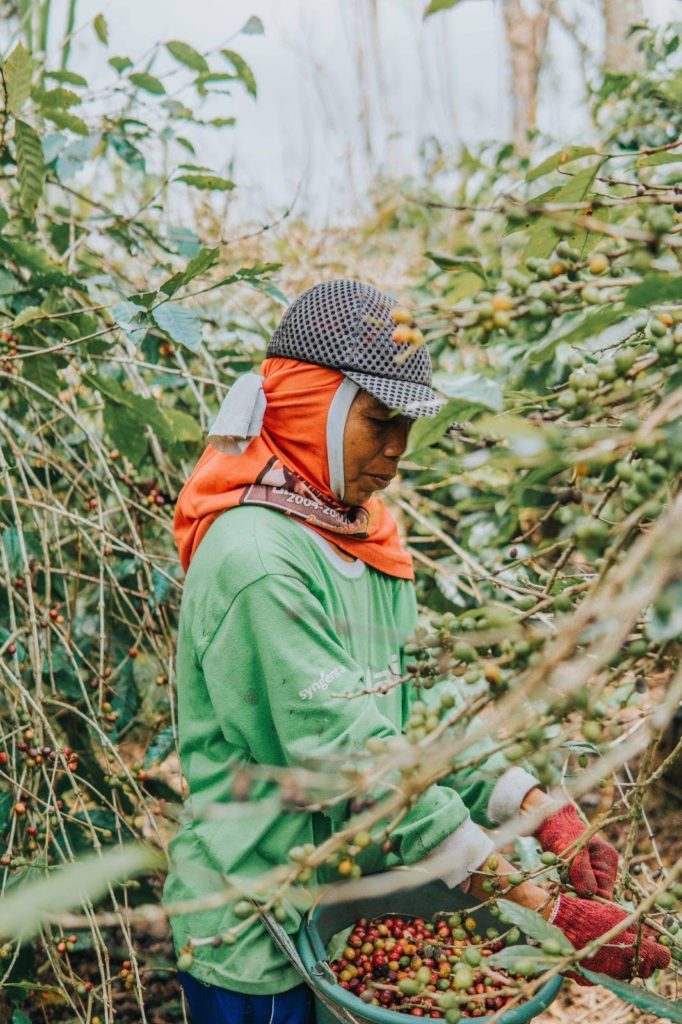
Coffee roasting
In today’s ever-popular coffee landscape, the increase in demand for speciality coffees has never been so high. So why not roast your own unique blend? At Miko, we can roast and pack your label coffee, helping you set yourself apart from your competitors.
Starting with a coffee tasting, our Master Roaster can advise on the best origins to match the taste profile that you are aiming for. Your coffee is roasted to order and delivered the next business day. This ensures absolute freshness and great-tasting coffee that is enjoyable all year round.
Milk
When it comes to enjoying a cup of coffee, the choice of milk can make all the difference. Each type of milk brings a unique flavour profile and texture. It is important for your baristas to understand the various types of milk that can be used in coffee and the distinctive characteristics they impart.
Types of milk
Milk plays a crucial role in coffee preparation. It adds creaminess, balances bitterness, and enhances the overall taste. The proteins and fats in milk bind with coffee compounds, mellowing the flavour and giving it a smooth texture. The choice of milk can significantly impact the final coffee experience.
The Classic: Whole Milk
Whole milk, also known as full-fat milk, is the traditional choice for coffee. With its rich and creamy texture, whole milk complements the coffee’s natural flavours and adds a touch of sweetness. It is an excellent choice for those who prefer a classic, indulgent coffee experience.
The Low-Calorie Option: Skimmed Milk
Skimmed milk is perfect for coffee enthusiasts watching their calorie intake. While it may not be as creamy as whole milk, it still adds a pleasant touch to the coffee without the extra fat.
The Dairy-Free Alternative: Almond Milk
Almond milk has gained popularity among those with lactose intolerance or those opting for a dairy-free lifestyle. It offers a slightly nutty flavour that pairs well with coffee’s bitterness. Almond milk is also low in calories, making it a favourite among health-conscious coffee drinkers.
The Rich and Nutty: Coconut Milk
Coconut milk brings a tropical twist to coffee with its rich, velvety texture and subtle coconut aroma. It offers a natural sweetness and is an excellent choice for those looking for a dairy-free, vegan option.
The Protein Powerhouse: Soy Milk
Soy milk is a popular choice for coffee lovers who seek a milk alternative with high protein content. It froths well, making it suitable for creating latte art, and provides a creamy consistency to the coffee.
The Oat Craze: Oat Milk
Oat milk has surged in popularity due to its creamy texture and slightly sweet taste. It blends harmoniously with coffee, making it a great dairy-free alternative for lattes and other espresso-based drinks.
The Trendsetter: Hemp Milk
Hemp milk is gaining popularity for its earthy flavor and nutritional benefits. It contains essential fatty acids and provides a unique taste that pairs well with various coffee blends.
The Lactose-Free Option: Lactose-Free Milk
For individuals with lactose intolerance, lactose-free milk allows them to enjoy their favourite coffee with the classic milk taste. It is real milk with the lactose removed, ensuring a smooth and creamy taste without any digestive issues.
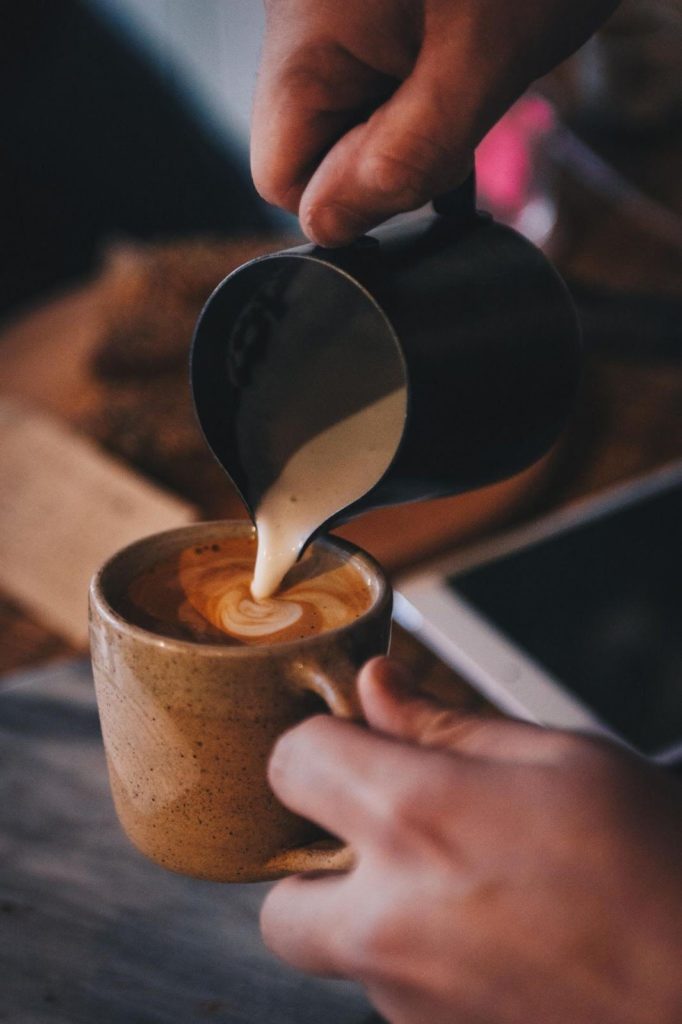
Steaming milk & Foaming Milk
Learning how to steam milk properly is an essential skill for any barista. Steamed milk refers to the process of heating milk with the use of steam produced by an espresso machine’s steam wand. The goal of steaming is to achieve a velvety, creamy texture known as microfoam. Microfoam is created by incorporating air into the milk, resulting in tiny, uniform bubbles that add smoothness and sweetness to the milk.
How to Steam Milk
- Use fresh milk, the milk should come straight out of the fridge.
- The most important thing that you should think about is control and control the jug with two hands.
- Do not do other things whilst you are steaming your milk, focus entirely on the milk.
- Start with a clean cold jug and use the right size of jug.
- Position the tip of the steam wand just below the surface of the milk, off centre of the milk jug.
- Turn on the steam wand and introduce air into the milk, called ‘stretching’ – Lower the jug slowly to get the tip of the steam wand below the surface of the milk maintain the steam wand same position – off centre.
- Breaking the surface of the milk with the tip of the steam wand will creates micro-foam by letting air gently into the milk while making the milk spin in a whirlpool motion. You should hear the foam being created by a hissing sound, but you should not see any bubbles.
- Foam the milk only when it is below 40 degrees Celsius, foaming above this temperature will create hard bubbles that you don’t want.
- When you have stretched the milk enough and you are happy with the amount of foam then place the steam wand a little deeper about 1cm- 2cm into the milk and wait till the temperature reaches to 60°C then turn off the steam and wipe your steam wand with a wet, clean cloth.
- Heat the milk only up to 150-160°F (65-70°C) MAX temperature.
- Before pouring, swirl the milk around the jug to polish the milk and to make sure the milk and micro-foam is together. The shinier and glossier the milk the better.
- Pour the steamed milk into your espresso or coffee cup.
* Best for: Steamed milk is ideal for drinks like lattes, cappuccinos, and flat whites, where the focus is on achieving a creamy, velvety texture that blends harmoniously with the coffee.
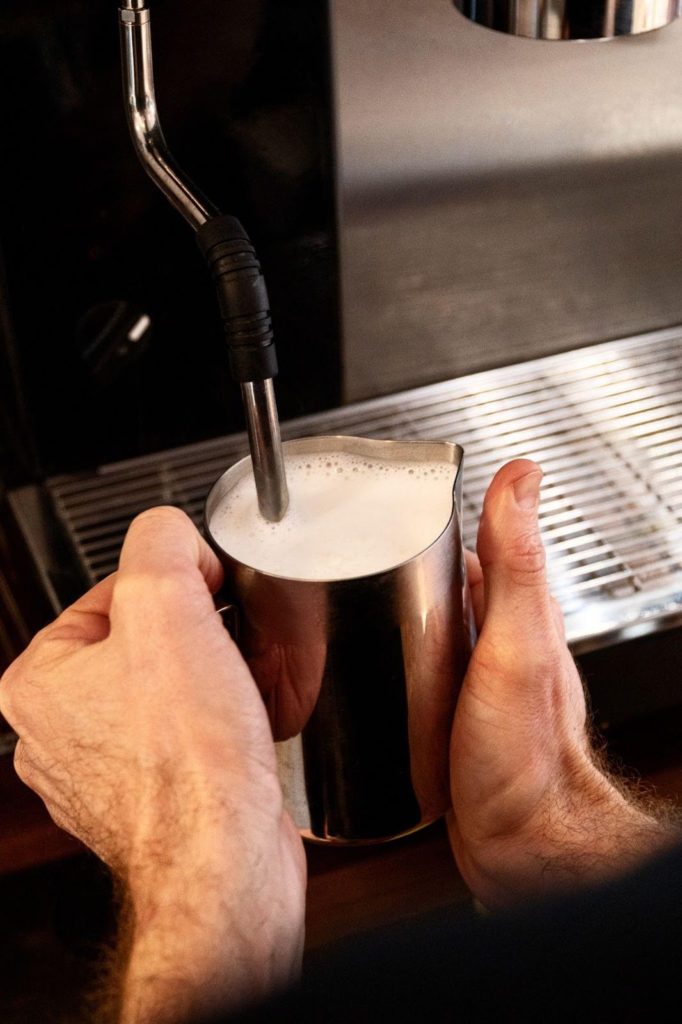
Latte Art
A skilled barista should be able to turn a simple cup of latte into a work of art. Follow our step-by-step guide to latte art.
The Canvas: Preparing the Perfect Latte
Before diving into the artistry, a well-brewed espresso and perfectly steamed milk serve as the foundation for latte art. A balanced espresso shot with a rich crema layer and smooth, velvety steamed milk will make the latte art process smoother and more enjoyable.
The Tools of the Trade
To create latte art, you will have to use specialist tools, namely a stainless steel milk pitcher. You may also want to use a latte art pen or stick. The milk pitcher allows them to steam and froth the milk properly, while the latte art pen or stick helps create intricate patterns and shapes.
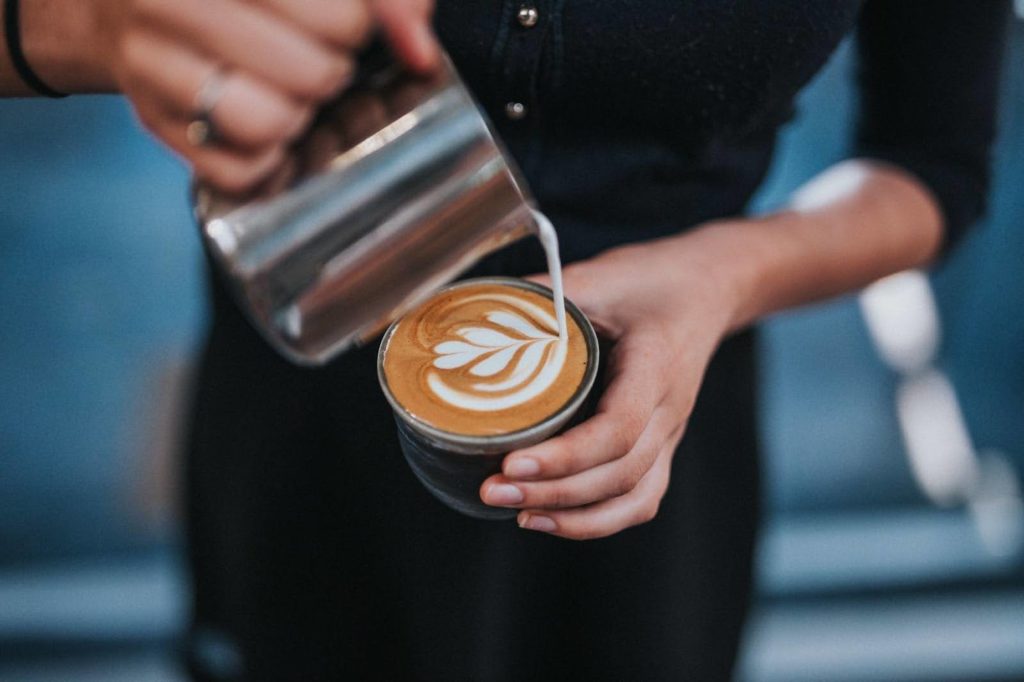
The Technique
1. Prepare the Milk
Begin with cold milk in the pitcher. Submerge the steam wand just below the surface and turn it on. Incorporate air into the milk to create microfoam, aiming for a velvety texture.
2. Steam the Milk
Heat the milk to around 150-160°F (65-70°C) while maintaining a swirling motion in the pitcher. This motion ensures even heating and the proper consistency of the milk.
3. Pour the Espresso
Brew a shot of espresso into a latte cup or glass.
4. Ready the Canvas
Gently tap the pitcher on the counter to eliminate any large bubbles in the milk. Swirl the milk to create a smooth and creamy texture.
5. The Pouring Technique
Hold the pitcher slightly above the surface of the espresso and begin pouring the milk in a controlled, steady stream. The key is to aim for the centre of the cup and pour at an even rate.
6. Create Patterns
Once the cup is half full, you can tilt the wide-mouthed cup back until it’s straight up. At the same time, move the pitcher of steamed milk right above the surface of the espresso. You should see some of the white microfoam appear in the espresso. You can now start making a design.
Designs
There are a range of different designs you can create with latte art. Begin with basic designs and gradually progress to more complex patterns as your skills improve. Latte art takes time and practice to master, so don’t be discouraged by initial attempts.
Heart
A heart design is created by pouring milk in a steady stream into the centre of the cup and then drawing a thin stream through the centre, which causes the pattern to split and form the shape of a heart.
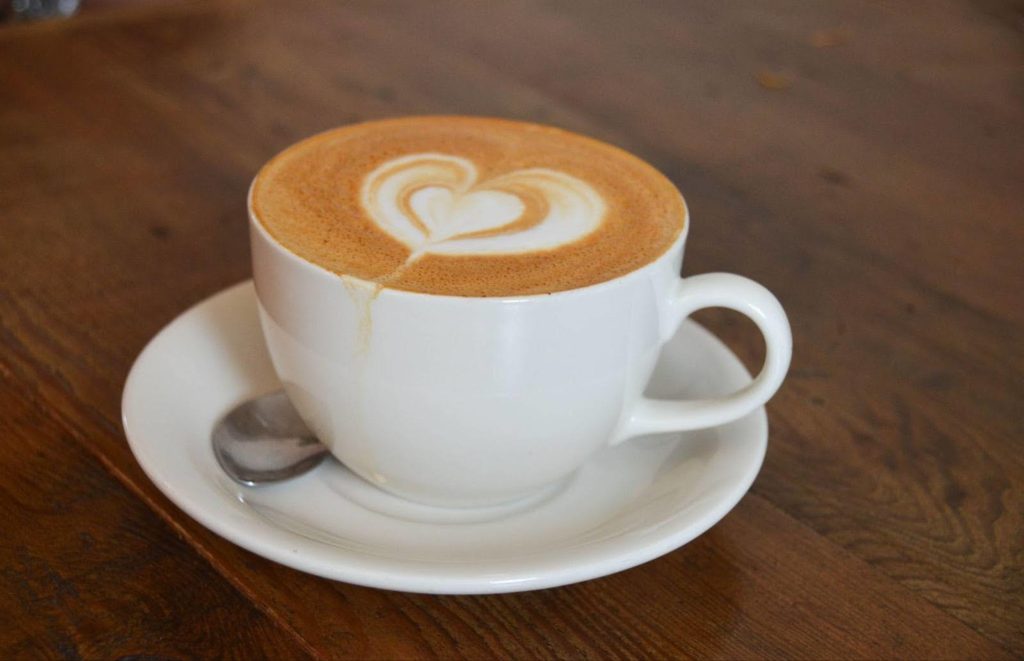
Tulip
The tulip design is achieved by pouring milk in a circular motion in the centre of the cup, creating a base. Then, add a vertical line from the centre of the base and proceed to create layers of petals around it using a back-and-forth motion.
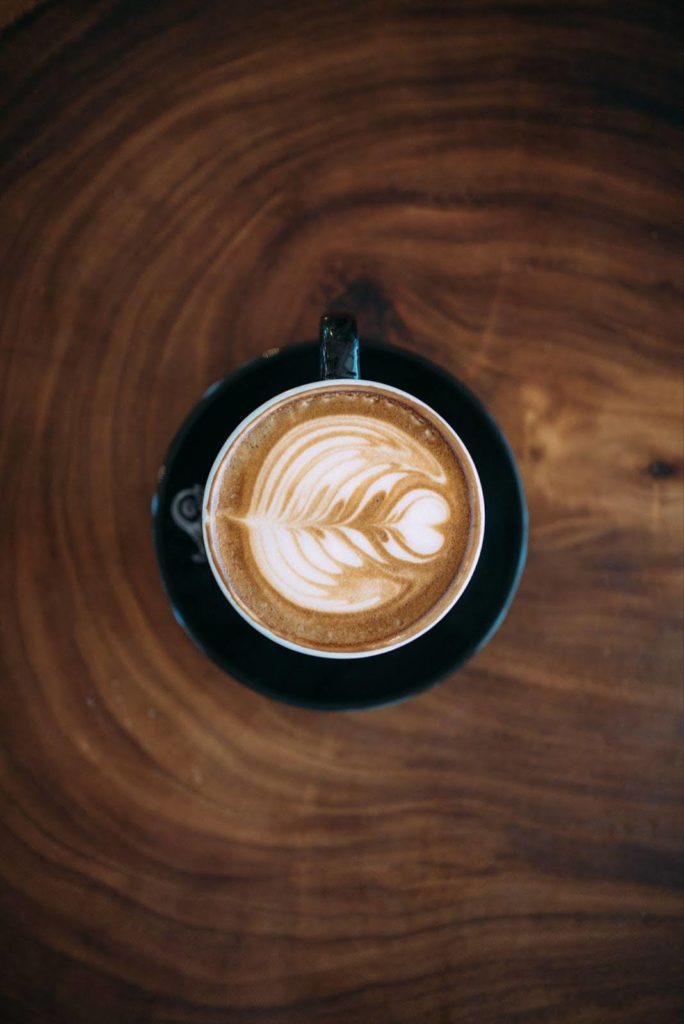
Rosetta
To create a rosetta, pour milk into the centre of the cup, and as the cup fills, move the pitcher from side to side while simultaneously moving it forward, creating a delicate leaf-like pattern.
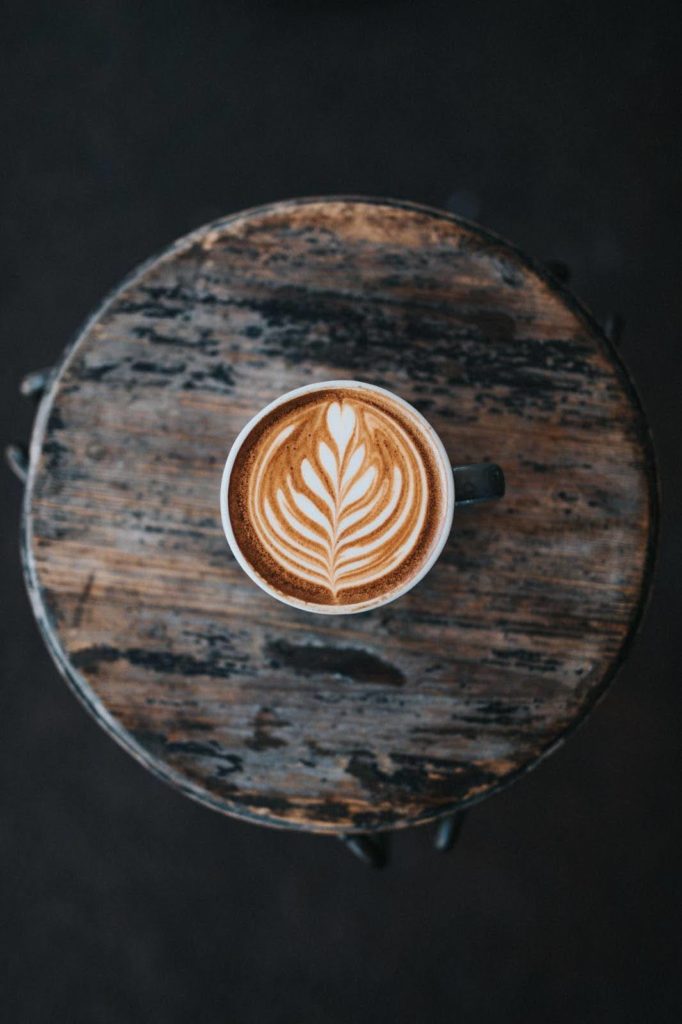
Swan
To create a swan, pour the milk in a controlled motion while drawing the base body of the swan. Then, add wings on both sides. You can refine the details using a latte art pen or stick to give it more of a swan-like appearance.
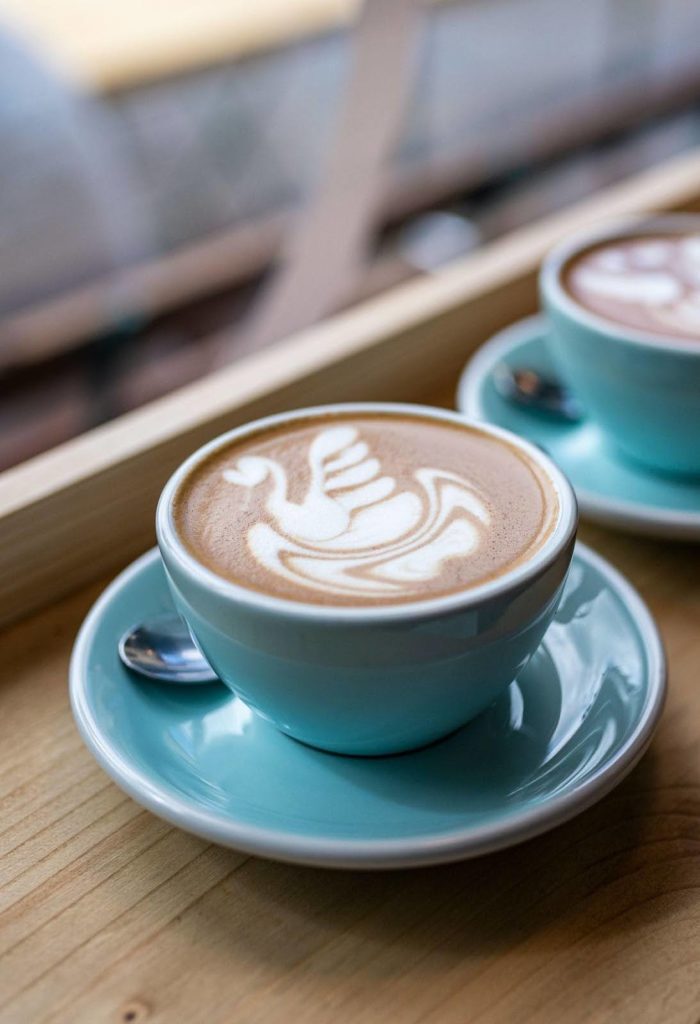
Iced Coffee
In the summer months, you may find customers asking for iced or cold drinks. It is therefore important that your baristas know how to make these.
Start by pulling an espresso using the coffee machine. You can use any type of coffee beans or grounds. Once the coffee is brewed, allow it to cool down to room temperature. You can speed up the process by transferring the hot coffee into a heat-safe container and placing it in the fridge.
Prepare your serving glass with ice. You can use regular ice cubes or coffee ice cubes for a stronger coffee flavour. Pour the cooled coffee over the ice, leaving some room at the top of the glass for the customer’s milk of choice.
You can sweeten the coffee with flavoured syrups, honey, or any other sweetener. Stir well to ensure the sweetener is fully dissolved. Finish with whipped cream or other toppings if the customer has requested them.
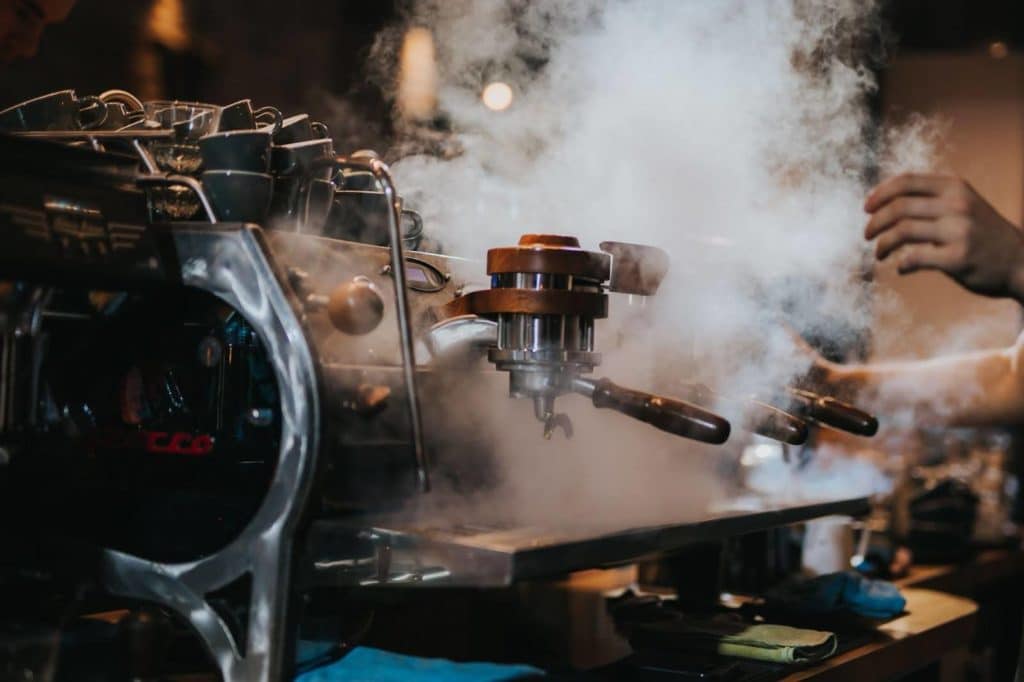
Getting To Know The Coffee Machine
It is vital for your baristas to get to know the different parts of the coffee machine. This will ensure that they have the ability to identify and potentially resolve any issues with the machine.
Water Reservoir
The water reservoir is a detachable container that holds water for brewing coffee. It is typically filled with cold, filtered water before brewing.
Portafilter
The portafilter is a handle-like device that holds the coffee grounds and attaches to the espresso machine. It often has a filter basket where the coffee grounds are placed. The portafilter is locked into the group head of the espresso machine for brewing.
Group Head
The group head is the part of the espresso machine where the portafilter is attached. It contains a valve that controls the flow of water into the portafilter during brewing.
Boiler
The boiler is a component that heats and maintains the water at the desired temperature for brewing. It is responsible for producing steam for steaming milk, as well as hot water for other beverages.
Steam Wand
The steam wand is a metal tube attached to the espresso machine. It is used to create steam for frothing or steaming milk. By opening the steam valve, steam is released, allowing you to heat and texture the milk.
Brew Head
The brew head is the part of the espresso machine where the hot water from the boiler is dispensed. It directs the water flow through the coffee grounds in the portafilter to extract the espresso.
Drip Tray
The drip tray is located beneath the brew head and portafilter. It collects any excess water, coffee, or spills during the brewing process.
Control Panel or Buttons
The control panel or buttons on the coffee machine allow you to control various functions, such as brewing, steaming, water temperature, and volume.
Steam and Water Controls
These controls enable you to adjust the flow rate of steam or hot water during steaming or brewing.
Cup Warmer
Some coffee machines have a cup warmer, usually located on the top of the machine. It provides a heated surface to pre-warm cups, helping to maintain the coffee’s temperature when poured.
Other Coffee Equipment
Grinder
A coffee grinder is used to grind whole coffee beans into the desired consistency. There are various types of grinders, including blade grinders and burr grinders, with burr grinders being preferred for achieving consistent particle size.
Scale
A scale is used to accurately measure the weight of coffee beans and water. It helps ensure precise coffee-to-water ratios for brewing methods such as pour-over, AeroPress, or espresso.
Kettle
A kettle with a gooseneck spout is often used for precise and controlled pouring during manual brewing methods like pour-over.
Coffee Filters
Paper filters or reusable metal filters are used in various brewing methods to separate coffee grounds from the brewed coffee.
Tamping Tool
A tamping tool is used to evenly compact coffee grounds in the portafilter before brewing espresso. It ensures consistent extraction by creating a level surface for the water to pass through.
Knock Box
A knock box is a container used to dispose of used coffee grounds and filter pucks. It allows for convenient and hygienic removal of coffee waste.
Thermometer
A thermometer helps monitor water temperature for brewing or steaming milk, ensuring optimal extraction or texturing.
Cleaning Tools
Brushes, cleaning solutions, and clothes are essential for maintaining cleanliness and hygiene of coffee equipment, such as portafilters, steam wands, and grinders.
Maintenance
Having baristas that can help with the upkeep of your coffee machines is vital. Regular maintenance ensures optimal performance, extends the machine’s lifespan, and guarantees the production of high-quality, delicious coffee.
Cleaning
Regular cleaning is crucial to keep your coffee equipment in optimal condition. Clean the portafilter, filter baskets, and steam wand after each use to remove coffee residue and milk buildup. Use appropriate cleaning brushes, cleaning solutions, and cloths to ensure thorough cleaning.
Descaling
Over time, mineral deposits (scale) can accumulate in coffee machines due to water hardness. Descaling is the process of removing these deposits to maintain proper functioning and performance. Follow the manufacturer’s instructions for descaling your specific coffee machine using descaling solutions or vinegar.
Grinder Maintenance
Clean your coffee grinder regularly to prevent coffee bean oils from building up and affecting the flavour. Disassemble the grinder and clean the burrs, hopper, and other removable parts according to the manufacturer’s instructions. Adjust and calibrate the grinder as needed to ensure consistent grind size.
Seal and Gasket Inspection
Regularly check the seals and gaskets on your coffee machine for signs of wear or damage. Replace any worn-out or damaged seals or gaskets promptly to maintain proper pressure and prevent leaks.
Water Filtration
Consider using a water filtration system to reduce mineral content and impurities in the water. This can help prolong the life of your coffee equipment by minimising scale buildup and maintaining optimal taste.
Regular Maintenance Checks
Periodically inspect your coffee equipment for any signs of malfunction, such as leaks, unusual noises, or inconsistent performance. Address any issues promptly by contacting the manufacturer’s service centre or a qualified technician.
Follow Manufacturer’s Guidelines
Always refer to the manufacturer’s instructions and guidelines for maintenance specific to your coffee equipment. They will provide detailed information on cleaning, maintenance schedules, and recommended products.
Your baristas will need to ensure that they maintain good standards of health and safety in the cafe.
This includes ensuring the coffee machine is placed on a stable and heat-resistant surface, and using caution when handling hot surfaces, such as the steam wand or the brew head.
Be mindful of electrical safety by keeping cords away from water and avoiding wet hands during operation. Store and handle coffee beans and grounds properly to maintain freshness and prevent contamination, and dispose of used coffee grounds and cleaning materials responsibly.
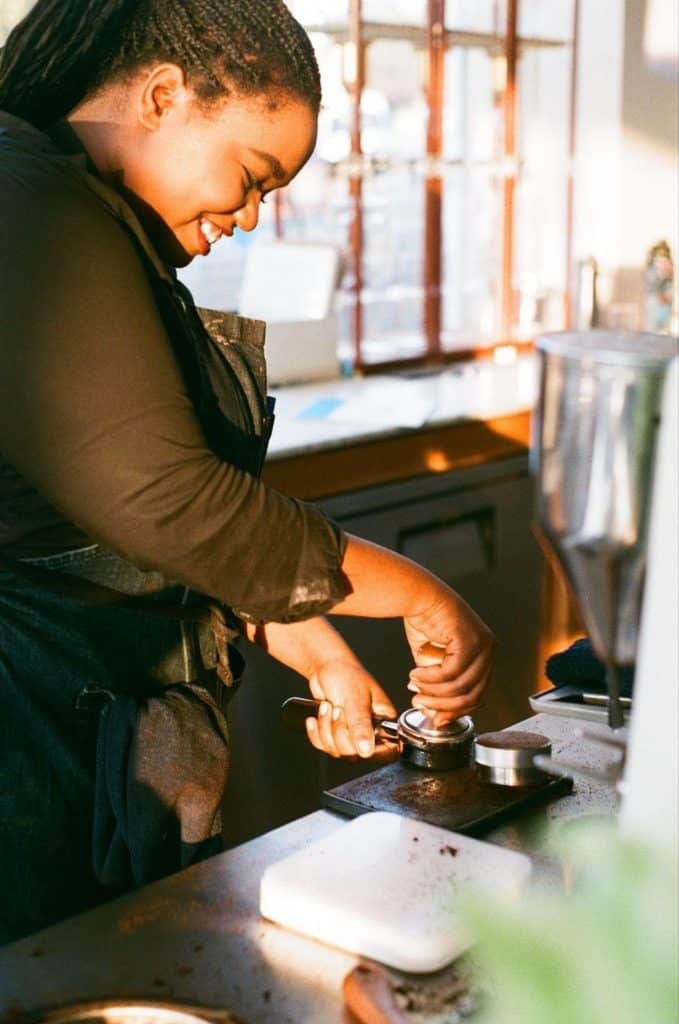
Health and Safety
Your baristas will need to ensure that they maintain good standards of health and safety in the cafe.
This includes ensuring the coffee machine is placed on a stable and heat-resistant surface, and using caution when handling hot surfaces, such as the steam wand or the brew head.
Be mindful of electrical safety by keeping cords away from water and avoiding wet hands during operation. Store and handle coffee beans and grounds properly to maintain freshness and prevent contamination, and dispose of used coffee grounds and cleaning materials responsibly.
Customer Service
The most successful cafes and coffee shops are not just all about great coffee but also have memorable customer service. Your baristas should take the time to get to know customers, remembering their favorite coffee orders and going the extra mile to ensure each cup is brewed to perfection.
Attention to detail
Pay attention to small details to enhance the overall customer experience. Ensure cleanliness, proper presentation, and quality control in every aspect of the business.
Creating memorable experiences:
Go beyond the basics to create memorable experiences that leave a lasting impression on customers. Personalise interactions, offer special promotions or surprises, and provide exceptional service.
Customer complaints
Handle customer complaints with empathy and professionalism. Listen actively, apologise when necessary, and work towards finding a satisfactory resolution. Use feedback from complaints to identify areas for improvement and implement necessary changes.
Service
Deliver prompt and efficient service to meet customer expectations. Be proactive in anticipating customer needs and provide assistance whenever possible. Offer a seamless and enjoyable experience throughout the entire customer journey.
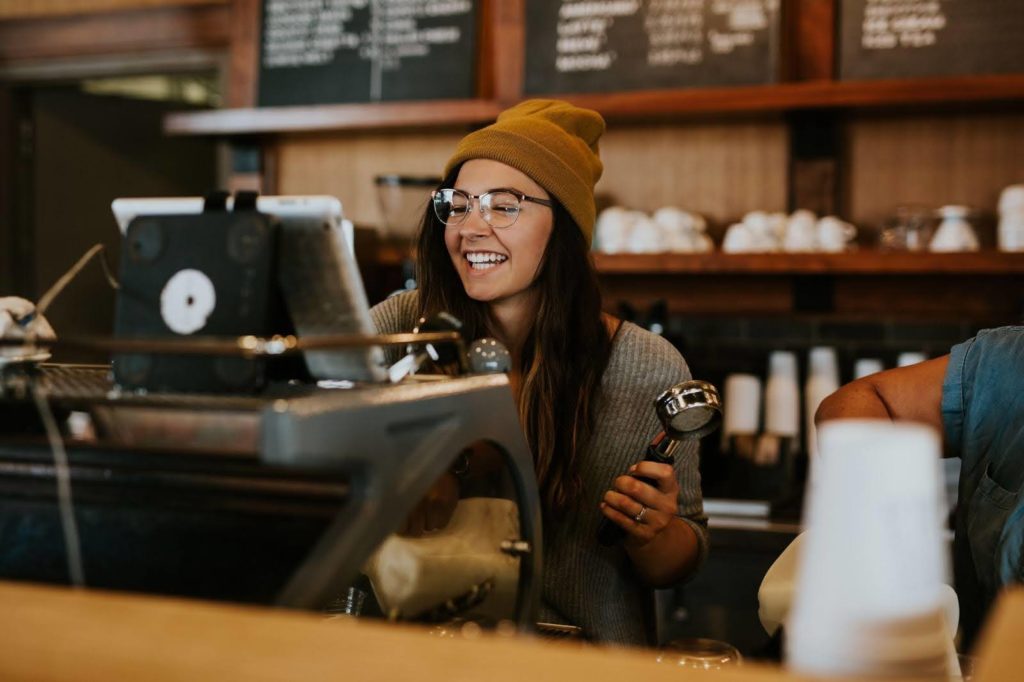
Maximise Team Efficiency
In order to maximise the efficiency of your team, you should have clearly defined team roles and responsibilities. This will ensure clarity and accountability. Make sure to clearly communicate expectations to each team member.
Assign roles based on individual strengths, skills, and expertise. Encourage training and flexibility to promote a well-rounded team. Regularly review and update responsibilities to adapt to evolving needs.
Learning and Development
The best teams are constantly learning and evolving. This may involve keeping up with the latest trends or attending coffee tastings and training sessions.
Improve Industry Knowledge
Stay informed about the coffee industry by reading industry publications, blogs, and news articles. Encourage your fellow baristas to follow industry experts and organisations on social media to stay updated with the latest developments.
Attend Coffee Tastings
Bring your team to coffee tastings to refine their sensory skills and gain a deeper understanding of different coffee flavours and profiles.
Attend Workshops
Attend workshops and training sessions to enhance technical skills, such as espresso preparation, latte art, or brewing methods. Look for professional development opportunities that provide hands-on experience and guidance from experts in the field.
Take a Barista Training Course
If you want your baristas to be professionally trained by some of the best in the business, why not enroll them on a SCA Certification Programme or City and Guilds Level 2 Barista Training Course.
SCA Certification
The SCA Coffee Skills Program is a modular, skills-based training program designed to prepare learners to gain more success in their career while contributing to the progress and evolution of the specialty coffee industry.
The Speciality Coffee Association (SCA) is the globally accredited organisation that represents coffee professionals all over the world. We offer a wide variety of courses that cover everything from how to brew a better cup of coffee at home to how to set up your own coffee shop.
Train The Trainer
Key member of your team is trained so as to train the rest of your staff and act as ambassador for your own coffee standard.
Coffee Manual
Bespoke coffee manuals created around your business functions.
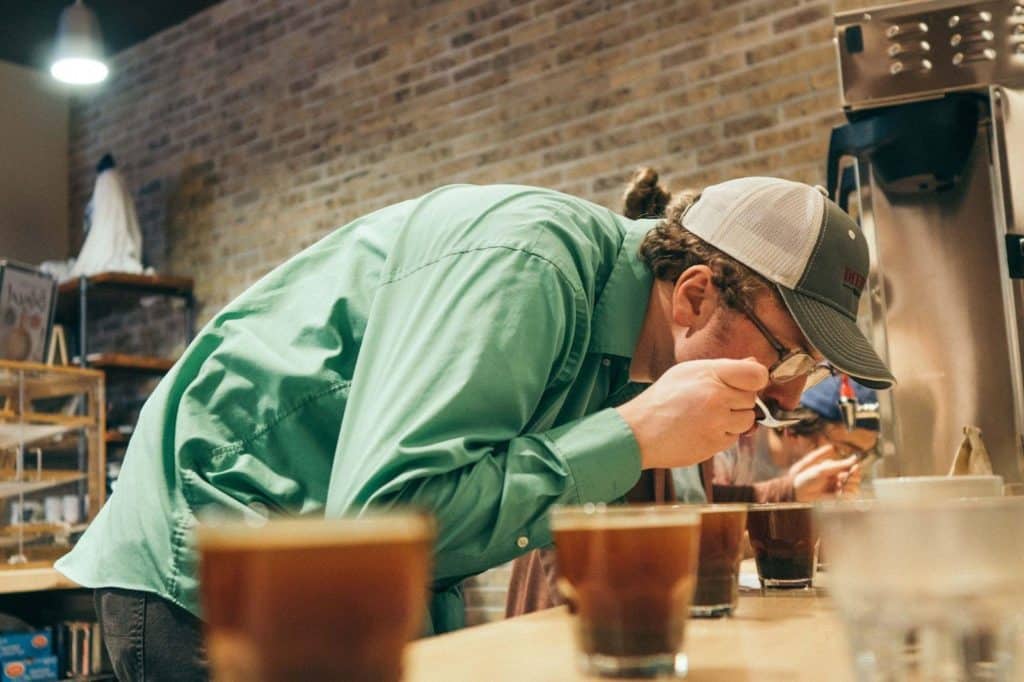
At Miko Coffee, we offer barista training at one of our four locations: Devon, Cornwall, Sheffield, North East and Scotland. The qualification centres on coffee and, in particular, espresso. However, it also incorporates filter coffee, tea, chocolate, juices and smoothies.
Your baristas will be given a background to the raw materials, training on how to produce a range of speciality drinks, learn how to operate, care for and maintain the equipment, and a run down on how to give the best customer service.
The barista training course consists of a minimum of 20 hours of class time and practice in the workplace before practical and written assessments. The training course lasts for 1 – 3 days.
If you are new to the industry and are looking to set up your own coffee shop, check out our recent guide.
WHAT’S NEW
Latest From Miko
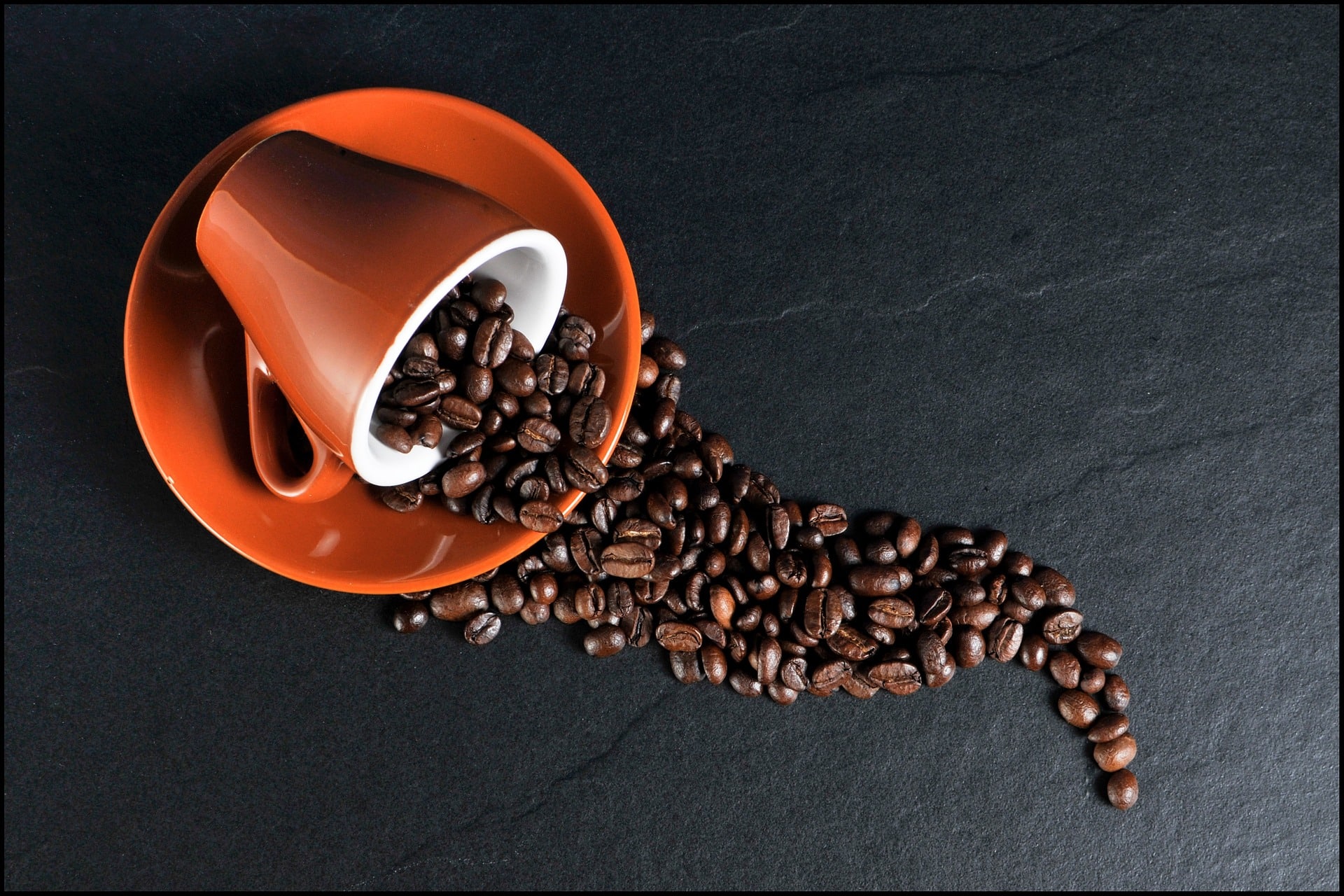
How Do Bean-to-Cup Coffee Machines Work?
If you’re considering a coffee machine for your business, you might find yourself overwhelmed by all the choices, especially when it comes
